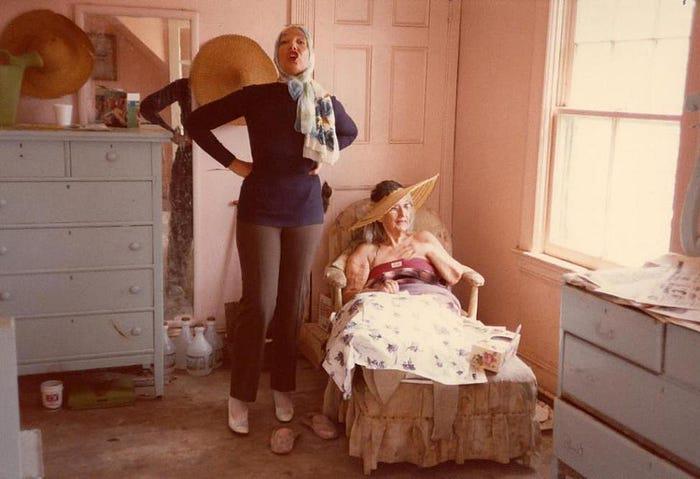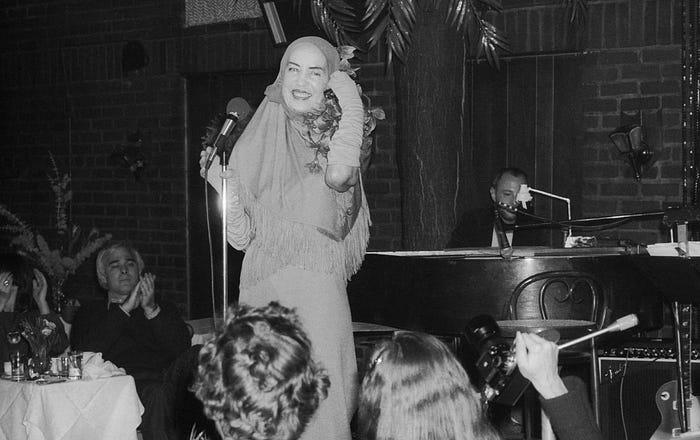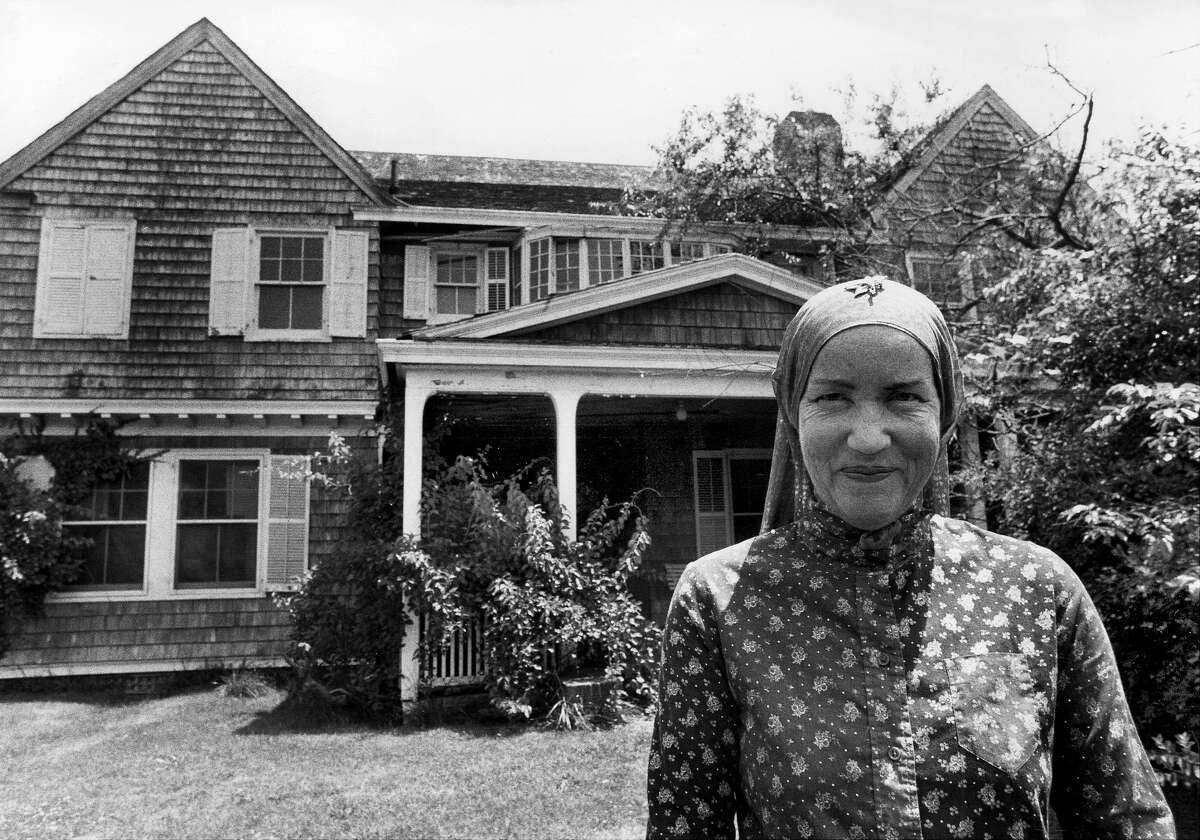In 1975, Albert and David Maysles filmed a documentary that rose to cult status due to the extraordinary nature of its two heroines. It began as a vanity project for Lee Radziwill to mythologize her own roots in the wealthy Bouvier family. Her sister was First Lady Jackie Kennedy, and the film temporarily revisited the lives of the two women, stealing another show from the sister. Primarily, this was because the director ultimately rejected Lee's ideas and decided to focus solely on a dilapidated house known as Grey Gardens. Given the state of the house itself, grey is the only color that comes to mind from the various shades of brown, due to it becoming a massive garbage dump for many cats. Amidst all this biohazard, there lies the paradox of two women closely related to the upper echelons of American society living in squalor.
This is the dark side of the American Dream that no one talks about. From riches to rags. It tends to become a road that does not come back, making it infinitely difficult. How did they even get that far in the first place? Edith Bouvier was a wealthy heiress who laid it all out for her. From debutante balls to wealthy husbands, or to the prolific socialite who didn’t have to worry about the mundane details of her harsh reality outside her golden bubble. However, as she would later learn the hard way, there is nothing in our lives. Unfortunately, she turned out to be a bit too eccentric for her father's taste. Another disaster struck in 1946 when her husband sent a telegram from Mexico with news of their divorce. He had a mistress and decided to elope. It reminded me of Carrie Bradshaw's Post-it breakup. In the end, Edith got the house, but there was no comfort. From the top of the mountain, she was suddenly reduced to a poor, mad cat lady.
It is almost heartbreaking to see her daughter eating raccoon leftovers in the attic of the house. Among all the souvenirs of their former life, there is a portrait that looks like a Russian countess from her youth, before everything went south. Listening to their ramblings, hints of mental illness emerge, with constant arguments, self-deprecating monologues, and bursts of song and dance. The old woman is now reduced to a quirky person living in a bed covered with cats, old photographs, and food. The other tries to grasp the last straw of sanity while getting caught up in something between hospice and prison. After losing her hair due to alopecia, she tightly wrapped her head in a shawl like a burrito and added Saudi Arabian spices to the Hamptons. After she added a brooch on top, it turned trauma into a fashion statement. From the very beginning, there is a sense of anxiety and discomfort due to the obviously codependent nature of the mother-daughter relationship.
What happened here is something that the lower class knows all too well. Outside the elite enclave, such people cannot lead decent lives because they do not need to learn how. There has always been someone to take care of the kitchen, gardening, and children. If a woman did not know how to drive, it was not due to patriarchy, but rather the fact that having a personal driver made a license redundant.
However, when you realize you are on the wrong side of that fence, consider that average people have learned to live and get by. Things continued to worsen, and the house became luxurious, starting to be eaten away by grapes, rodents, and dust, hitting rock bottom. The sad thing about it is that humans can adapt to almost anything. For beer, this was not a reason to leave, but their neighbors asked them to oppose.

In fact, at least to make the house habitable again and prevent its demolition, intervention was needed from Jackie Kennedy herself. If you did not know who these women were, you might mistake the documentary for a rather extreme episode of the TV show Hoarders. Listening to the mother talk about her former glory days, you might feel she resembles the fictional Miss Havisham from Charles Dickens' great expectations. A delusional woman who is reluctant to acknowledge reality from the past, wandering like a sunken ship. One of the qualities that make this such an important part of the documentary genre is how it prompts viewers to reconsider the choices and influences that parents potentially have on their children. In a scene of harsh honesty, the daughter longs for the freedom that the patriarch cruelly denies her.
The film may provoke unexpected anxiety attacks in conservative singles, especially after Edith begins to recite a long list of wealthy men lined up for her to suggest to her fussy daughter. Yes, she might have lived in a grand mansion swaying with her husband and children instead of this dump. But it must be her own decision. And she doubles down on it by telling her at 56. Whatever she is trying to do in her life is too late. Especially with the singing career she longed for in her life in New York, where she left her position in her father's company to pursue her ambitions. Unfortunately, those were hardly anything but modeling. It was a career choice that was beyond the understanding of anyone at her station at the time. When she later confesses to the camera, she has now settled into a single room in New York to escape Grey Gardens. There is genuine despair in her voice.

We all go through such stages regarding our own parents. You feel estranged or suffocated, and finding common ground where you are not at each other's throats is an achievement. This is especially true in multigenerational living, where a considerable number of people live under the same roof. There are issues of freedom and privacy, along with all the underlying problems that come with it. It is important not to mistake mutual dependence for each other, as the other can be very toxic. It is difficult to see a mother decline in old age or suffer from health issues when you are trying to share something deeper than just a surname. In a world where moving out on your own is treated as an important milestone, it is easy to overlook these bridges that connect us to the significant people who shaped us into adults.
In my corner of the woods, enabling parents to move into a nursing home is almost considered an insult. Still, it doesn’t have to be a bad idea. The unpleasant real estate of the film is a world that the elderly middle class enjoys in Florida before kicking the bucket. That’s why they say it’s the place to die. Even better, the place to die. No one here knows whether to allow their parents to endure the horrors of Grey Gardens. When Mama's beloved passes away, the other stayed there to fulfill the promise she made to her. Watching their slow-motion meltdown feels voyeuristic and inappropriate, but you cannot look away. Many viewers condemned Big Edie as a vile, manipulative creature who could not handle the prospect of living on her own. This is much closer to live-action Cinderella than a happy ending with Prince Charming, and far more irritating than anything you would get from Disney.

The house was later sold, and she finally gave up on her dream of a music career and began to pursue it. However, her shows in New York met with disastrous reviews that she was never meant to see. The tragedy of her life is that she discovered it was too late for her to place all her hopes in it. But perhaps there is a silver lining to it. Had she dedicated all those years to chasing a stage career instead of giving raccoons in her mother's past decay, she might have remained anonymous. In this way, her dream was realized, but in another way. Grey Gardens remains enchanting. In 2009, director Michael Sucsy turned it into a film with Jessica Lange and Drew Barrymore. In 2006, composer Scott Frankel created a musical with the same name, featuring lyrics by Michelle Brourman.
What the Maysles brothers encountered in 1975 is now recognizable. The beer was sold on the condition that it remained preserved. The new owners invested enough time and money to restore it to its original beauty. I think the true Cinderella is the house. The only one of the three that got a happy ending. The last inmate moved to Bal Harbour in 1997 and passed away at 84 in 2002. As a final dig, she is said to have been discovered five days after her death. Whatever she was thinking about her accomplishments, she was immortalized in a way that was not necessarily flattering, but certainly revolutionary. It anticipated modern reality shows like MTV's Osbournes. Ozzy was certainly a successful musician, but many of his antics were infinitely more irritating than these two women, who starkly highlighted loneliness and misery.
